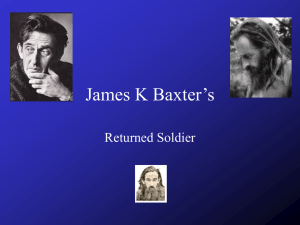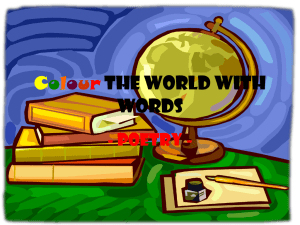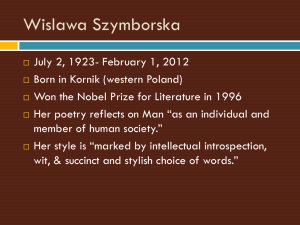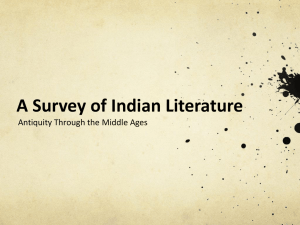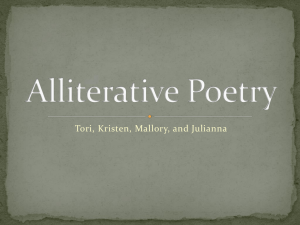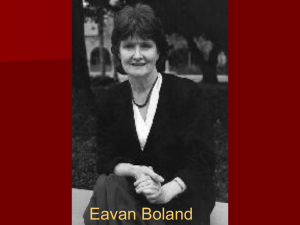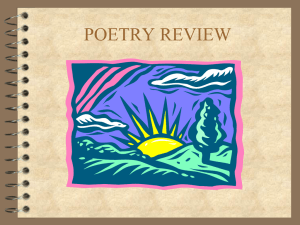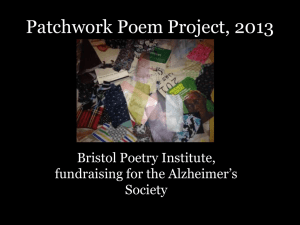PowerPoint
advertisement
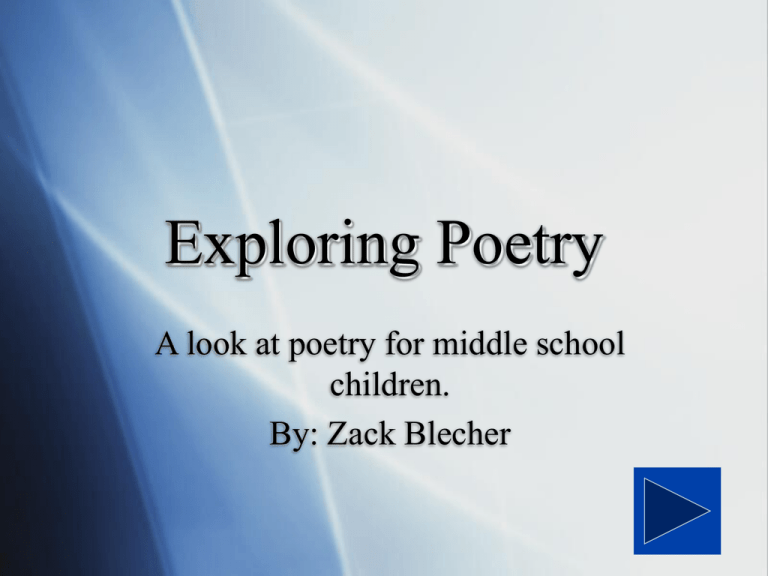
Exploring Poetry A look at poetry for middle school children. By: Zack Blecher Welcome Everyone! Today we are going to look at the wonderful subject of poetry. We are going to explore what poetry actually is and is not, some conventions of poetry and some forms of poetry. After carefully reviewing all the information there will be a short quiz. Navigation This button will take you to the next screen This button will take you to the previous screen Lastly, when you see this button you will be taken to the main menu. Main Menu Lesson One Lesson Two What is Poetry Conventions Lesson Three Lesson Four Forms Quiz What is Poetry? Poetry according to the dictionary is the art of rhythmical composition, written or spoken, for exciting pleasure by beautiful, imaginative, or elevated thoughts. Yet, what does this actually mean. from www.dictionary.com To begin it may actually be easier to start by knowing what poetry is not. The opposite of poetry is prose. Prose is considered the ordinary form of spoken or written language, without metrical structure. We will discuss meter in the convention section. Poetry is not the same as a novel. Although at the same time poetry can tell a story. from www.dictionary.com There are various styles of writing under the heading of poetry. Two broad categories of poetry are free verse and metered verse. To find examples of both of these simply go to the example section from the main menu. “One does not only wish to be understood when one writes; one wishes just as surely to not be understood” ~Friedrich Nietzsche Poetry has been around for ages. Dating back to the days of ancient Greece. The stories The Iliad and The Odyssey were both elongated poems by Homer. Also from the East came the 1000 verse poems The Ramayana and The Mahabharata (both of which would be memorized by a single person!). Moving forward in time we come to Shakespeare and his use of iambic pentameter not to mention his many Sonnets. Now that we understand what poetry is we now need to learn some specific conventions of poetry. Please return to the main menu and go to lesson 2. Conventions It is impossible to cover every convention of poetry in one PowerPoint presentation. That being said we will concentrate on these conventions: •Alliteration •Metaphor and Simile •Personification •Hyperbole Alliteration Alliteration, simply put, is a repeated sound at the beginning of a word. Alliteration is a pervasive poetic convention and is employed by most poets in one form or another. “Painting is silent poetry, and poetry is a speaking picture.” ~ Simonides Alliteration A lot of poetry is meant not to be read from a page but spoken aloud. Poets are masters of language and know how certain sounds will ‘feel’ when spoken. Alliteration lends itself nicely to this: Burgundy beauties beguiled by bemused bandits. Metaphor and Simile Two closely related conventions that are widely utilized by poets are metaphor and simile. These two terms are very similar yet slightly different. Both take two or more things and draw a comparison between them. Yet a metaphor says one thing is another while a simile says one thing is like another. A small but important difference. Metaphor and Simile An example of both of these is as follows (the metaphor and simile are the underlined parts): Metaphor- The blanket kissing my cheek - which is the fullest ripe apple - teases me into sleep. Simile- Insects stick to my face like an unruly beard. “Imagination is the only weapon in the war against reality.” ~ Jules de Gautier Personification Personification is a poetic device used that gives an object or animal human characteristics. Below is an example of this poetic devise. The lingering luscious smoke spoke to me. Notice that there are actually two conventions here: personification and alliteration. Hyperbole Hyperbole is a fancy word for excessive exaggeration. Poets sometimes use this to make the importance of something more obvious to the reader. Examples: Her hate was greater than all the armies of the world. “I could eat a horse” “Poetry lies its way to truth.” ~ John Ciardi Now that you have learned about a few conventions you should return to the main menu and explore some of the forms of poetry. Be sure to pay attention to the the differences between the forms of poetry mentioned there. “A poem is never finished, only abandoned.” ~ Paul Valery Forms of Poetry Like conventions there are many forms and styles of poetry. In this PowerPoint presentation we will concentrate on three different kinds of poetry: •Haiku •Limerick •Free Verse Haiku The haiku is a highly controlled ancient Japanese form of poetry. The haiku uses a certain number of syllables. Syllables are the segments of parts of words. The form haiku has 17 syllables in total. The syllables are broken up into 5 in the first line 7 in the second line and then 5 again in the last line. Haiku A lot of the time Haikus include subjects involving nature but this is not a requirement of haikus. Here is an example of a Haiku (the syllables are marked with the red numbers, note one word can have more than one syllable): 1| 2 | 3 | 4 | 5 I love the tree’s shade 1| 2 |3| 4 | 5|6 | 7 it keeps me cool all day long 1 | 2 | 3 |4| 5 resting there is nice. Limerick A limerick is a poem that has a certain rhyme scheme, meaning that it rhymes a certain way. The rhyme scheme is as follows: lines 1, 2 and 5 rhyme with each other and lines 3 and 4 rhyme with each other. To visualize this you can use letters to show which lines rhyme together. A limerick would look like this: A A B A B Limerick Here is an example of a limerick: “There once was a man from Peru who dreamed he was eating his shoe he awoke in the night with a terrible fright and found out it was quite true” Free Verse Free verse poetry does not have a discernable rhyme or rhythm pattern. Free verse poetry has become more and more popular in recent years. An example of a free verse poem can be seen on the next slide. Free Verse Thick woolen socks cocoons of the most industrious silk worms - enveloped his feet: guards (strong willed and brainless) against the ever creeping cold. Each foot covered in mold, that climbed the trunk of healthy wood. Would not, could not be comforted by the socks Extra Forms If you are interested in learning more about forms of poetry click here. The website contains several different forms that we did not go over in this PowerPoint. They will not be covered on the quiz but if you enjoyed learning about these three forms there are many MANY more just waiting to be discovered. Quiz Do you feel you are ready for the quiz? When you wish to begin the quiz click the picture of the pencils to the right. To pick an answer click the lettered box next to the next that you think is the answer. Question 1 How are the haiku’s 17 syllables broken up? A five, seven, five B three, five, nine C five, five , seven Correct! That’s right! The haiku is divided into five syllables in the first line, seven in the second line, and then five again in the third line. Click the arrow for the next question. Please Try Again Well that is the right number of syllables in a Haiku but not the right numbers. Please try again by pressing the arrow or return to the main menu to re-read the section on forms of poetry. Please Try Again That was very close. Think about the order of the lines. You can either go back to try again by pressing the arrow or return to the main menu to re-read some information. Question 2 What does the poetic convention hyperbole mean? A The repeated sound at the beginning of a word B Giving an object human characteristics C Excessive exaggeration to emphasize a point Correct! That’s right hyperbole is excessive exaggeration. This is used to emphasize importance. Click the arrow to advance to the final question. Please Try Again No that is not correct. The repeated sound at the beginning of a word is alliteration not hyperbole. Either return to the question by pressing the arrow or return to the main menu to review. Please Try Again Sorry that is incorrect. Giving an object human characteristics is personification not hyperbole. Either return to the question by pressing the arrow or return to the main menu to review. Question 3 Poetry is ___________________? A rhythmical composition, written or spoken, for exciting pleasure by beautiful, imaginative, or elevated thoughts B ordinary form of spoken or written language, without metrical structure C A story told by pictures in segmented sections Correct! That’s correct! Poetry is indeed a rhythmical composition, written or spoken, for exciting pleasure by beautiful, imaginative, or elevated thoughts. That’s the end of the quiz. Hopefully you have a new love of poetry and want to learn more. Please click the diploma at the bottom of the page to set the PowerPoint up for the next student. Please Try Again Sorry that’s not correct. Ordinary spoken word with no metrical verse is called prose not poetry. Please either click the arrow button to return to the question or the main menu button to review the slides. Please Try Again Sorry please try again. You may have been thinking about comics. Either click the arrow to return to the question to try again or the main menu button to review some information.
